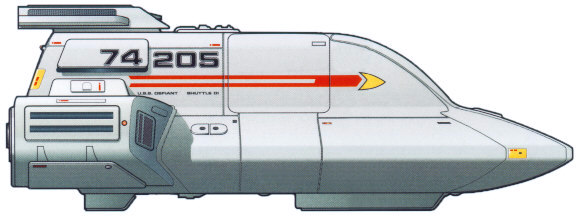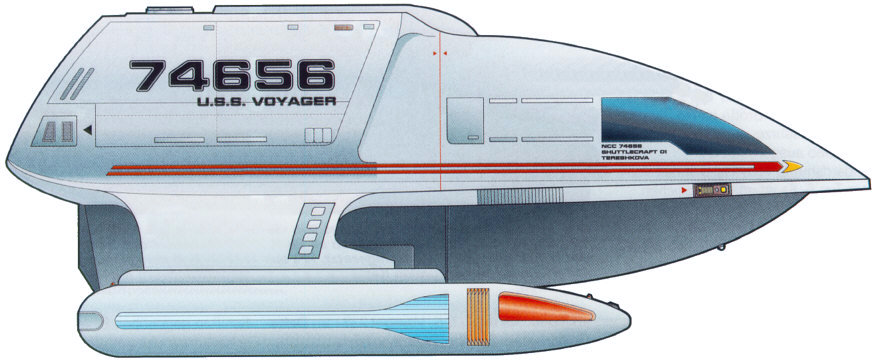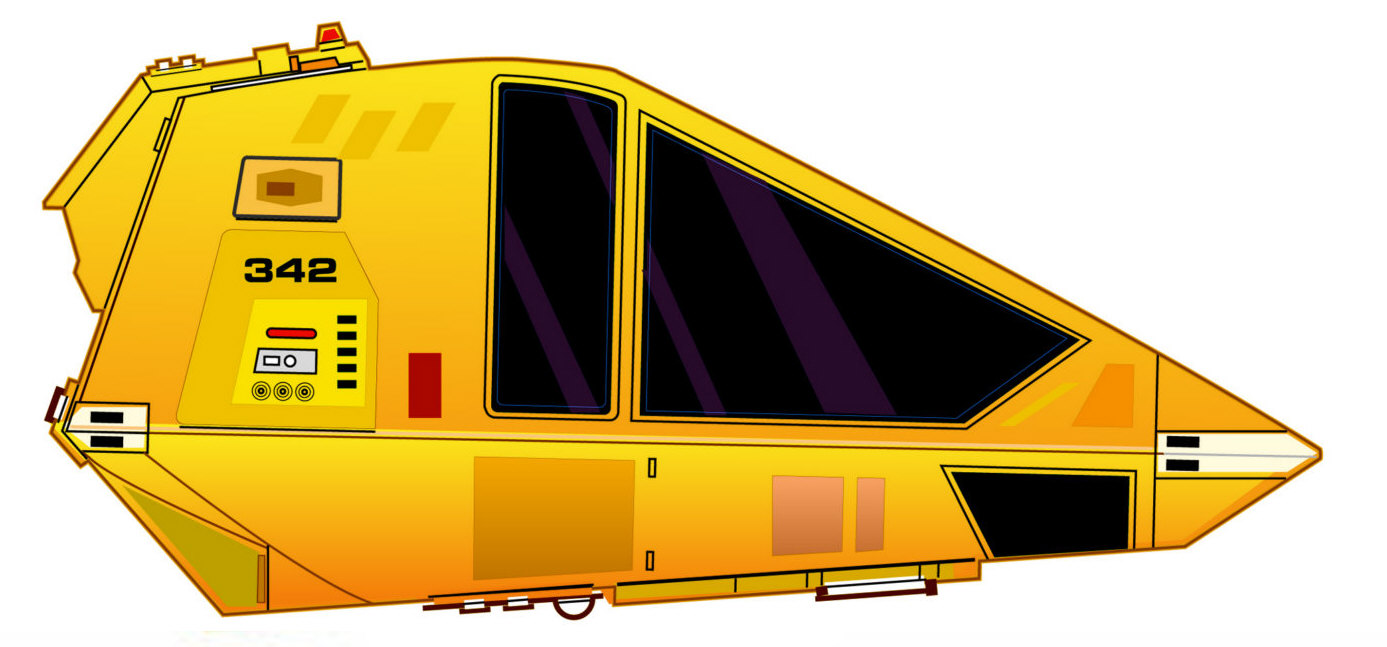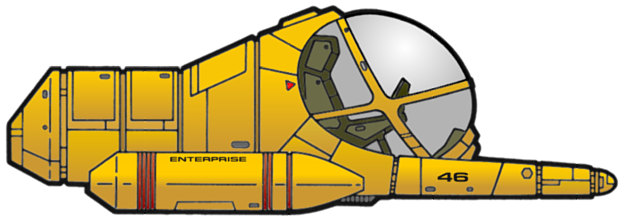Auxiliary Craft
Created by Captain María Zavala on Mon Jun 17th, 2024 @ 2:07am
Carina Station is equipped with a number of auxiliary craft meant to assist the crew in carrying out their mission. These range from the smaller, single-occupant maintenance craft to the standard personnel shuttles and more. Most are launched, recovered, stored, and maintained in the six cavernous bays (or 'wedges') that make up the midline of the station.
The type and combination of auxiliary craft is ultimately determined by the commanding officer, with input from the chief operations officer, and can vary from facility to facility.
Auxiliary craft likely to be found aboard Carina Station as of 2396 are as follows:

The Type 18 shuttlepod, introduced in the early 2370s, quickly established itself as a smart and reliable successor to earlier designs, particularly when it came to planetary surface operations and ship-to-ship transfers. It can accommodate up to two flight crew with either four passengers or cargo in the aft compartment. Though limited to impulse speeds when under its own power, if released while at warp speed, it can sustain the velocity by generating its own subspace field.

The Type 8 personnel shuttle, introduced in the mid 2360s, is a successor to the earlier Type 6 shuttle, incorporating many of the technological developments of 'Project Galaxy', including reinforced pylons, an upgraded power plant, and improved hull contouring. Additional modularity allows configuration for-purpose with strip phaser emitters, enhanced sensor palates, or additional cargo storage as needed. For this reason, the Type 8 continues to be valued, especially aboard smaller starships and facilities.

The Type 9 personnel shuttle, introduced in the early 2370s, was created specifically for missions requiring rapid response, speed, and maneuverability instead of crew carrying capacity. Advancements such as modern warp engines, phaser arrays, advanced sensors, and padless transporters are equipped as standard. To further facilitate its use across the fleet, this small, streamlined shuttle can be housed inside a cargo bay or drop-launch berth and requires minimal maintenance or pre-launch checks.

The Type 11 personnel shuttle, introduced in the early 2370s, is a successor to the earlier Type 7 shuttle of the mid-twenty-fourth century. Developed in parallel with the latest advances in starship design technology, this craft is equipped with an impressive array of offensive and defensive systems as well as a more refined propulsion system. Spaces within the shuttle are semi-modular and can be adapted for a variety of missional needs, up to and including extended-duration flights.

The Type 17 cargo shuttle, introduced in the mid-2370s, was created to meet transport needs of vessels and installations, particularly those operating on the frontier. It only needs a crew of two, though includes a small crew rest area in the middle of the craft to allow team members to use the shuttle as a home base. The hold is specially designed to carry not only a wide variety of cargo units, but also buggies or other ground vehicles to support work on a planet’s surface.

The Danube class runabout, introduced in the mid-2360s, arose out of a mandate to develop a small, versatile vessel for use in a wide range of missions. Each craft has a standardized cockpit and warp sled, which is supplemented by modular compartments that can be swapped out at any starbase facility to best suit the needs of the assignment (e.g. scientific research, personnel and supply transfer, command and control, support craft for larger vessels and installations).

The Cargo Management Unit (i.e. "Workbee"), introduced in its current form by the early 2270s, has been a mainstay of Federation and Starfleet operations. In addition to being found at stations and construction facilities, units are also assigned to starships in the field to assist with a variety of inspection, repair, and transportation tasks. Each individual unit is run by a single operator, either in pressurized or unpressurized configuration (with the operator in an environmental suit).

The Sphinx Workpod, seen in use as early as the mid-2350s, serves as a more robust counterpart to the Workbee and is often found aboard space-based stations as well as Starfleet’s largest starships. Each unit is capable of supporting a pilot and a cargo specialist, who helps manage and oversee cargo operations.
Sources: Descriptions adapted from Memory Alpha, Memory Beta, and additional technical sources.
The type and combination of auxiliary craft is ultimately determined by the commanding officer, with input from the chief operations officer, and can vary from facility to facility.
Auxiliary craft likely to be found aboard Carina Station as of 2396 are as follows:

The Type 18 shuttlepod, introduced in the early 2370s, quickly established itself as a smart and reliable successor to earlier designs, particularly when it came to planetary surface operations and ship-to-ship transfers. It can accommodate up to two flight crew with either four passengers or cargo in the aft compartment. Though limited to impulse speeds when under its own power, if released while at warp speed, it can sustain the velocity by generating its own subspace field.

The Type 8 personnel shuttle, introduced in the mid 2360s, is a successor to the earlier Type 6 shuttle, incorporating many of the technological developments of 'Project Galaxy', including reinforced pylons, an upgraded power plant, and improved hull contouring. Additional modularity allows configuration for-purpose with strip phaser emitters, enhanced sensor palates, or additional cargo storage as needed. For this reason, the Type 8 continues to be valued, especially aboard smaller starships and facilities.

The Type 9 personnel shuttle, introduced in the early 2370s, was created specifically for missions requiring rapid response, speed, and maneuverability instead of crew carrying capacity. Advancements such as modern warp engines, phaser arrays, advanced sensors, and padless transporters are equipped as standard. To further facilitate its use across the fleet, this small, streamlined shuttle can be housed inside a cargo bay or drop-launch berth and requires minimal maintenance or pre-launch checks.

The Type 11 personnel shuttle, introduced in the early 2370s, is a successor to the earlier Type 7 shuttle of the mid-twenty-fourth century. Developed in parallel with the latest advances in starship design technology, this craft is equipped with an impressive array of offensive and defensive systems as well as a more refined propulsion system. Spaces within the shuttle are semi-modular and can be adapted for a variety of missional needs, up to and including extended-duration flights.

The Type 17 cargo shuttle, introduced in the mid-2370s, was created to meet transport needs of vessels and installations, particularly those operating on the frontier. It only needs a crew of two, though includes a small crew rest area in the middle of the craft to allow team members to use the shuttle as a home base. The hold is specially designed to carry not only a wide variety of cargo units, but also buggies or other ground vehicles to support work on a planet’s surface.

The Danube class runabout, introduced in the mid-2360s, arose out of a mandate to develop a small, versatile vessel for use in a wide range of missions. Each craft has a standardized cockpit and warp sled, which is supplemented by modular compartments that can be swapped out at any starbase facility to best suit the needs of the assignment (e.g. scientific research, personnel and supply transfer, command and control, support craft for larger vessels and installations).

The Cargo Management Unit (i.e. "Workbee"), introduced in its current form by the early 2270s, has been a mainstay of Federation and Starfleet operations. In addition to being found at stations and construction facilities, units are also assigned to starships in the field to assist with a variety of inspection, repair, and transportation tasks. Each individual unit is run by a single operator, either in pressurized or unpressurized configuration (with the operator in an environmental suit).

The Sphinx Workpod, seen in use as early as the mid-2350s, serves as a more robust counterpart to the Workbee and is often found aboard space-based stations as well as Starfleet’s largest starships. Each unit is capable of supporting a pilot and a cargo specialist, who helps manage and oversee cargo operations.
Sources: Descriptions adapted from Memory Alpha, Memory Beta, and additional technical sources.
Updated: 05/02/2025
Categories: Carina Station Reference